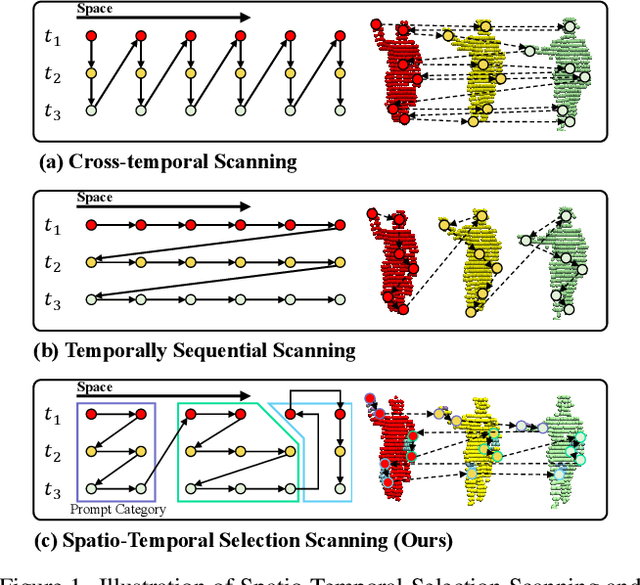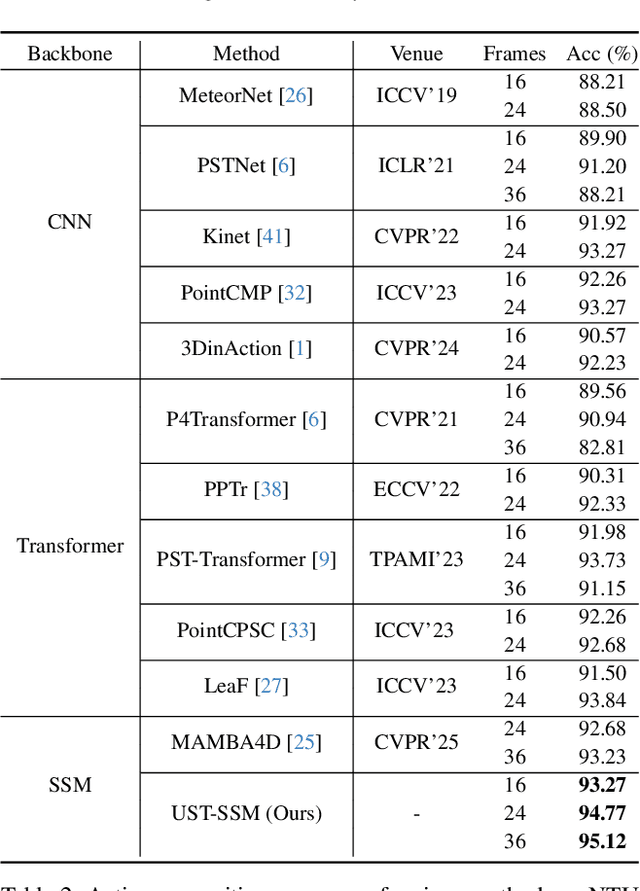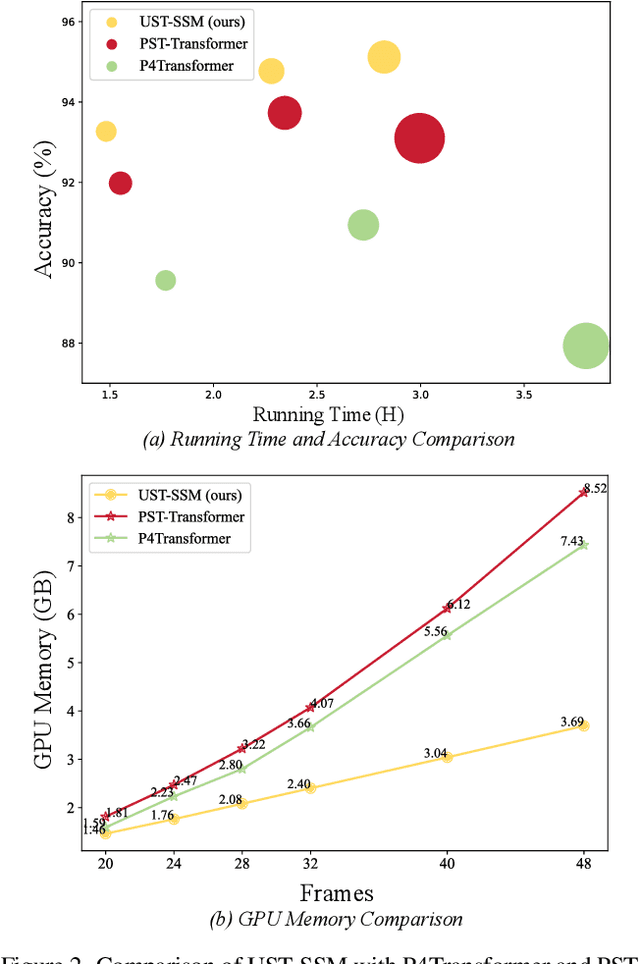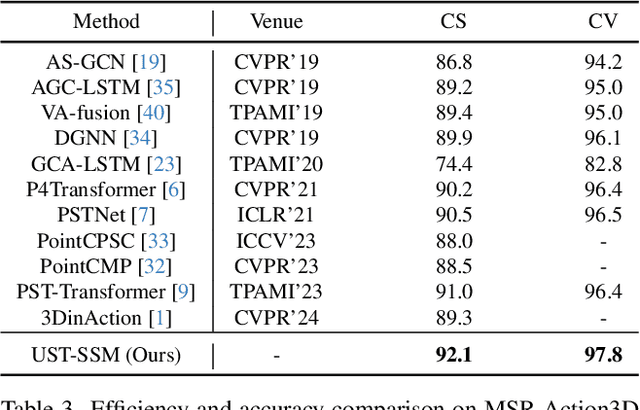Mengyuan Liu
PoseMoE: Mixture-of-Experts Network for Monocular 3D Human Pose Estimation
Dec 18, 2025Abstract:The lifting-based methods have dominated monocular 3D human pose estimation by leveraging detected 2D poses as intermediate representations. The 2D component of the final 3D human pose benefits from the detected 2D poses, whereas its depth counterpart must be estimated from scratch. The lifting-based methods encode the detected 2D pose and unknown depth in an entangled feature space, explicitly introducing depth uncertainty to the detected 2D pose, thereby limiting overall estimation accuracy. This work reveals that the depth representation is pivotal for the estimation process. Specifically, when depth is in an initial, completely unknown state, jointly encoding depth features with 2D pose features is detrimental to the estimation process. In contrast, when depth is initially refined to a more dependable state via network-based estimation, encoding it together with 2D pose information is beneficial. To address this limitation, we present a Mixture-of-Experts network for monocular 3D pose estimation named PoseMoE. Our approach introduces: (1) A mixture-of-experts network where specialized expert modules refine the well-detected 2D pose features and learn the depth features. This mixture-of-experts design disentangles the feature encoding process for 2D pose and depth, therefore reducing the explicit influence of uncertain depth features on 2D pose features. (2) A cross-expert knowledge aggregation module is proposed to aggregate cross-expert spatio-temporal contextual information. This step enhances features through bidirectional mapping between 2D pose and depth. Extensive experiments show that our proposed PoseMoE outperforms the conventional lifting-based methods on three widely used datasets: Human3.6M, MPI-INF-3DHP, and 3DPW.
KLO-Net: A Dynamic K-NN Attention U-Net with CSP Encoder for Efficient Prostate Gland Segmentation from MRI
Dec 15, 2025Abstract:Real-time deployment of prostate MRI segmentation on clinical workstations is often bottlenecked by computational load and memory footprint. Deep learning-based prostate gland segmentation approaches remain challenging due to anatomical variability. To bridge this efficiency gap while still maintaining reliable segmentation accuracy, we propose KLO-Net, a dynamic K-Nearest Neighbor attention U-Net with Cross Stage Partial, i.e., CSP, encoder for efficient prostate gland segmentation from MRI scan. Unlike the regular K-NN attention mechanism, the proposed dynamic K-NN attention mechanism allows the model to adaptively determine the number of attention connections for each spatial location within a slice. In addition, CSP blocks address the computational load to reduce memory consumption. To evaluate the model's performance, comprehensive experiments and ablation studies are conducted on two public datasets, i.e., PROMISE12 and PROSTATEx, to validate the proposed architecture. The detailed comparative analysis demonstrates the model's advantage in computational efficiency and segmentation quality.
H$_{2}$OT: Hierarchical Hourglass Tokenizer for Efficient Video Pose Transformers
Sep 08, 2025



Abstract:Transformers have been successfully applied in the field of video-based 3D human pose estimation. However, the high computational costs of these video pose transformers (VPTs) make them impractical on resource-constrained devices. In this paper, we present a hierarchical plug-and-play pruning-and-recovering framework, called Hierarchical Hourglass Tokenizer (H$_{2}$OT), for efficient transformer-based 3D human pose estimation from videos. H$_{2}$OT begins with progressively pruning pose tokens of redundant frames and ends with recovering full-length sequences, resulting in a few pose tokens in the intermediate transformer blocks and thus improving the model efficiency. It works with two key modules, namely, a Token Pruning Module (TPM) and a Token Recovering Module (TRM). TPM dynamically selects a few representative tokens to eliminate the redundancy of video frames, while TRM restores the detailed spatio-temporal information based on the selected tokens, thereby expanding the network output to the original full-length temporal resolution for fast inference. Our method is general-purpose: it can be easily incorporated into common VPT models on both seq2seq and seq2frame pipelines while effectively accommodating different token pruning and recovery strategies. In addition, our H$_{2}$OT reveals that maintaining the full pose sequence is unnecessary, and a few pose tokens of representative frames can achieve both high efficiency and estimation accuracy. Extensive experiments on multiple benchmark datasets demonstrate both the effectiveness and efficiency of the proposed method. Code and models are available at https://github.com/NationalGAILab/HoT.
UST-SSM: Unified Spatio-Temporal State Space Models for Point Cloud Video Modeling
Aug 20, 2025



Abstract:Point cloud videos capture dynamic 3D motion while reducing the effects of lighting and viewpoint variations, making them highly effective for recognizing subtle and continuous human actions. Although Selective State Space Models (SSMs) have shown good performance in sequence modeling with linear complexity, the spatio-temporal disorder of point cloud videos hinders their unidirectional modeling when directly unfolding the point cloud video into a 1D sequence through temporally sequential scanning. To address this challenge, we propose the Unified Spatio-Temporal State Space Model (UST-SSM), which extends the latest advancements in SSMs to point cloud videos. Specifically, we introduce Spatial-Temporal Selection Scanning (STSS), which reorganizes unordered points into semantic-aware sequences through prompt-guided clustering, thereby enabling the effective utilization of points that are spatially and temporally distant yet similar within the sequence. For missing 4D geometric and motion details, Spatio-Temporal Structure Aggregation (STSA) aggregates spatio-temporal features and compensates. To improve temporal interaction within the sampled sequence, Temporal Interaction Sampling (TIS) enhances fine-grained temporal dependencies through non-anchor frame utilization and expanded receptive fields. Experimental results on the MSR-Action3D, NTU RGB+D, and Synthia 4D datasets validate the effectiveness of our method. Our code is available at https://github.com/wangzy01/UST-SSM.
Human-in-Context: Unified Cross-Domain 3D Human Motion Modeling via In-Context Learning
Aug 14, 2025Abstract:This paper aims to model 3D human motion across domains, where a single model is expected to handle multiple modalities, tasks, and datasets. Existing cross-domain models often rely on domain-specific components and multi-stage training, which limits their practicality and scalability. To overcome these challenges, we propose a new setting to train a unified cross-domain model through a single process, eliminating the need for domain-specific components and multi-stage training. We first introduce Pose-in-Context (PiC), which leverages in-context learning to create a pose-centric cross-domain model. While PiC generalizes across multiple pose-based tasks and datasets, it encounters difficulties with modality diversity, prompting strategy, and contextual dependency handling. We thus propose Human-in-Context (HiC), an extension of PiC that broadens generalization across modalities, tasks, and datasets. HiC combines pose and mesh representations within a unified framework, expands task coverage, and incorporates larger-scale datasets. Additionally, HiC introduces a max-min similarity prompt sampling strategy to enhance generalization across diverse domains and a network architecture with dual-branch context injection for improved handling of contextual dependencies. Extensive experimental results show that HiC performs better than PiC in terms of generalization, data scale, and performance across a wide range of domains. These results demonstrate the potential of HiC for building a unified cross-domain 3D human motion model with improved flexibility and scalability. The source codes and models are available at https://github.com/BradleyWang0416/Human-in-Context.
Masked Clustering Prediction for Unsupervised Point Cloud Pre-training
Aug 12, 2025



Abstract:Vision transformers (ViTs) have recently been widely applied to 3D point cloud understanding, with masked autoencoding as the predominant pre-training paradigm. However, the challenge of learning dense and informative semantic features from point clouds via standard ViTs remains underexplored. We propose MaskClu, a novel unsupervised pre-training method for ViTs on 3D point clouds that integrates masked point modeling with clustering-based learning. MaskClu is designed to reconstruct both cluster assignments and cluster centers from masked point clouds, thus encouraging the model to capture dense semantic information. Additionally, we introduce a global contrastive learning mechanism that enhances instance-level feature learning by contrasting different masked views of the same point cloud. By jointly optimizing these complementary objectives, i.e., dense semantic reconstruction, and instance-level contrastive learning. MaskClu enables ViTs to learn richer and more semantically meaningful representations from 3D point clouds. We validate the effectiveness of our method via multiple 3D tasks, including part segmentation, semantic segmentation, object detection, and classification, where MaskClu sets new competitive results. The code and models will be released at:https://github.com/Amazingren/maskclu.
Recognizing Actions from Robotic View for Natural Human-Robot Interaction
Jul 30, 2025



Abstract:Natural Human-Robot Interaction (N-HRI) requires robots to recognize human actions at varying distances and states, regardless of whether the robot itself is in motion or stationary. This setup is more flexible and practical than conventional human action recognition tasks. However, existing benchmarks designed for traditional action recognition fail to address the unique complexities in N-HRI due to limited data, modalities, task categories, and diversity of subjects and environments. To address these challenges, we introduce ACTIVE (Action from Robotic View), a large-scale dataset tailored specifically for perception-centric robotic views prevalent in mobile service robots. ACTIVE comprises 30 composite action categories, 80 participants, and 46,868 annotated video instances, covering both RGB and point cloud modalities. Participants performed various human actions in diverse environments at distances ranging from 3m to 50m, while the camera platform was also mobile, simulating real-world scenarios of robot perception with varying camera heights due to uneven ground. This comprehensive and challenging benchmark aims to advance action and attribute recognition research in N-HRI. Furthermore, we propose ACTIVE-PC, a method that accurately perceives human actions at long distances using Multilevel Neighborhood Sampling, Layered Recognizers, Elastic Ellipse Query, and precise decoupling of kinematic interference from human actions. Experimental results demonstrate the effectiveness of ACTIVE-PC. Our code is available at: https://github.com/wangzy01/ACTIVE-Action-from-Robotic-View.
GPA-RAM: Grasp-Pretraining Augmented Robotic Attention Mamba for Spatial Task Learning
Apr 28, 2025



Abstract:Most existing robot manipulation methods prioritize task learning by enhancing perception through complex deep network architectures. However, they face challenges in real-time collision-free planning. Hence, Robotic Attention Mamba (RAM) is designed for refined planning. Specifically, by integrating Mamba and parallel single-view attention, RAM aligns multi-view vision and task-related language features, ensuring efficient fine-grained task planning with linear complexity and robust real-time performance. Nevertheless, it has the potential for further improvement in high-precision grasping and manipulation. Thus, Grasp-Pretraining Augmentation (GPA) is devised, with a grasp pose feature extractor pretrained utilizing object grasp poses directly inherited from whole-task demonstrations. Subsequently, the extracted grasp features are fused with the spatially aligned planning features from RAM through attention-based Pre-trained Location Fusion, preserving high-resolution grasping cues overshadowed by an overemphasis on global planning. To summarize, we propose Grasp-Pretraining Augmented Robotic Attention Mamba (GPA-RAM), dividing spatial task learning into RAM for planning skill learning and GPA for grasping skill learning. GPA-RAM demonstrates superior performance across three robot systems with distinct camera configurations in simulation and the real world. Compared with previous state-of-the-art methods, it improves the absolute success rate by 8.2% (from 79.3% to 87.5%) on the RLBench multi-task benchmark and 40\% (from 16% to 56%), 12% (from 86% to 98%) on the ALOHA bimanual manipulation tasks, while delivering notably faster inference. Furthermore, experimental results demonstrate that both RAM and GPA enhance task learning, with GPA proving robust to different architectures of pretrained grasp pose feature extractors. The website is: https://logssim.github.io/GPA\_RAM\_website/.
Learning Occlusion-Robust Vision Transformers for Real-Time UAV Tracking
Apr 12, 2025



Abstract:Single-stream architectures using Vision Transformer (ViT) backbones show great potential for real-time UAV tracking recently. However, frequent occlusions from obstacles like buildings and trees expose a major drawback: these models often lack strategies to handle occlusions effectively. New methods are needed to enhance the occlusion resilience of single-stream ViT models in aerial tracking. In this work, we propose to learn Occlusion-Robust Representations (ORR) based on ViTs for UAV tracking by enforcing an invariance of the feature representation of a target with respect to random masking operations modeled by a spatial Cox process. Hopefully, this random masking approximately simulates target occlusions, thereby enabling us to learn ViTs that are robust to target occlusion for UAV tracking. This framework is termed ORTrack. Additionally, to facilitate real-time applications, we propose an Adaptive Feature-Based Knowledge Distillation (AFKD) method to create a more compact tracker, which adaptively mimics the behavior of the teacher model ORTrack according to the task's difficulty. This student model, dubbed ORTrack-D, retains much of ORTrack's performance while offering higher efficiency. Extensive experiments on multiple benchmarks validate the effectiveness of our method, demonstrating its state-of-the-art performance. Codes is available at https://github.com/wuyou3474/ORTrack.
Performance Analysis of Deep Learning Models for Femur Segmentation in MRI Scan
Apr 05, 2025Abstract:Convolutional neural networks like U-Net excel in medical image segmentation, while attention mechanisms and KAN enhance feature extraction. Meta's SAM 2 uses Vision Transformers for prompt-based segmentation without fine-tuning. However, biases in these models impact generalization with limited data. In this study, we systematically evaluate and compare the performance of three CNN-based models, i.e., U-Net, Attention U-Net, and U-KAN, and one transformer-based model, i.e., SAM 2 for segmenting femur bone structures in MRI scan. The dataset comprises 11,164 MRI scans with detailed annotations of femoral regions. Performance is assessed using the Dice Similarity Coefficient, which ranges from 0.932 to 0.954. Attention U-Net achieves the highest overall scores, while U-KAN demonstrated superior performance in anatomical regions with a smaller region of interest, leveraging its enhanced learning capacity to improve segmentation accuracy.
 Add to Chrome
Add to Chrome Add to Firefox
Add to Firefox Add to Edge
Add to Edge